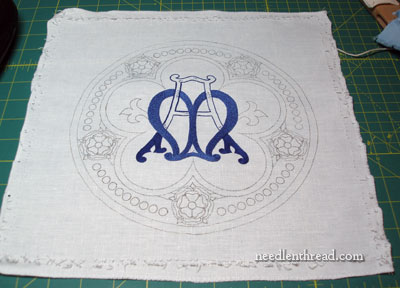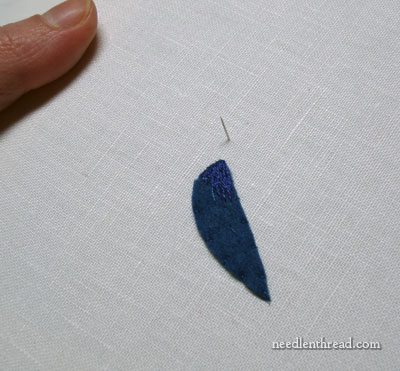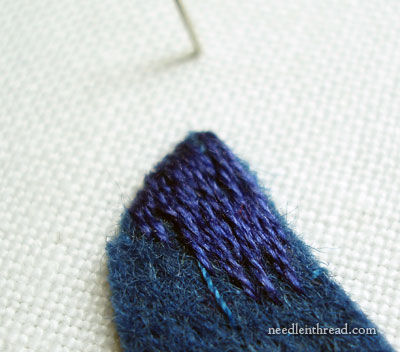After finishing the background for the Medallion project, my next step was to tackle the monogram in the middle of the design.

Remember this? When I first started the Medallion project, I made it this far in filling in the central monogram with silk, using Soie d’Alger and stem stitch. But because I wasn’t pleased with my stitching set-up – the frame I was using was too small – and because I had some ideas churning around in my head that I thought would improve the project, I decided to stop progress on my first attempt, and start all over again.
When I restarted the project, I began with the background, filling it with flat silk and goldwork vermicelli, and that brought me to this point:

… which I showed you the other day.
But now it’s time to reconsider the monogram.
Once the vermicelli and silk background was finished – and the whole time I was working on it, really – I faced the fact that the monogram must be slightly raised. It needs to stand out a bit from the background, and the stem stitch filling that was worked on the first round of the project wouldn’t really suffice. Yes, with a little “drop shadow” around the monogram, I could somewhat “fake” the look I wanted, but I didn’t want to do that – I really wanted the monogram to sit up above the background slightly.
I considered several ideas about the stitching: I could go with padded satin stitch, and, while retaining the outline of the monogram, break the monogram into more manageable areas that would take satin stitch well. I could work something like a raised stem stitch, and in fact, I could do that over padding, kind of like Casalguidi embroidery, though not as raised, but this would require some fiddly work to get the crispness of the monogram design to remain intact and to get all the various “splits” in different parts of the design to flow well.

And then I thought about previous designs I’ve worked that were solidly filled with stitching, and immediately this golden pomegranate goldwork and silk project designed by Margaret Cobleigh jumped into my head. This project required that the solid silk filling (stitched in long and short stitch) be worked over felt. I remember enjoying that project a lot, and working the long and short stitch filling over felt was not difficult at all.
Self, I said, Why not? You can use the same method – long and short stitch filling – in silk, over felt! And so I set about testing.

Before charging straight ahead with any new, untested idea on a large project, it’s a good idea to test a smaller sample first. So out came a snippet of felt. I am using a dark blue wool felt, since the filling will be a darker blue as well. Obviously, a contrasting color of felt won’t do the job here – the color needs to be similar to the color of the embroidery thread.
A very handy practice, when working a large project, is to have a “doodle cloth” of sorts set up nearby. A doodle cloth is a place where you can practice or test a technique to see if it’s going to work for you, before working the technique on your larger project. I always make sure my doodle cloth is the same fabric I’m working the larger project on, and any technique I want to fiddle with on the doodle cloth is fiddled out in the same materials that I’ll be working with on the larger project. That way, I’ve covered most variables. The doodle cloth for this project is framed up on an Evertite frame. It’s small enough to keep handy on the worktable.
I stitched down a small piece of wool felt on the doodle cloth. I used a darkish blue sewing thread to sew down the felt. The silk will cover that sewing thread.

You can see that it’s a small piece of felt – there’s no point in working out some large test piece on the doodle cloth, just to find that it works or doesn’t work. A little test piece will suffice. You can’t really tell in the photo above that there’s actually some stitching on that felt. The dark blue felt and the dark silk are close enough in color and shade that it is quite difficult to see the stitching at this point. It’s even worse when doing the stitching!

Here, you can see it a bit better. The long and short stitch over the felt works ok – no doubt about it – but wow! The dark-on-dark embroidery is difficult and tricky. It would be very easy to leave little gaps in the stitching and never notice them until the whole piece is finished.

I tried a little touch of stem stitch on the felt, too. Stem stitch worked over felt, when you want a very smooth, consistent surface, is tricky, too. The tension on the working thread has to be absolutely consistent – more so than when working directly on linen – because the stitches can sink into the felt. I didn’t like the look of the stem stitch on the felt at all – as much of it as can be seen, anyway. In that photo above, if you look closely, there’s also gap in the rows of stem stitch which I did not see until I cropped this photo.
So, that was my trial to see whether or not a filling stitched over wool felt would do the job for the monogram.
I drew some conclusions, made some adjustments, tested something else, and made a decision. And we’ll talk about that later!
If you’d like to follow along with this project and read the whole backstory, see what materials and tools I’m using, and watch the techniques worked out and discussed, you’ll find all the articles on the Medallion Project listed here.
If you’d like access to all the tips and techniques discussed in the Medallion Project, including complete step-by-step coverage of the Tudor-Style Rose, conveniently collected in one document, interlinked, referenced, and indexed, why not add the Marian Medallion Project e-book to your library? It’s packed full of all kinds of embroidery tips for undertaking a project like this, all in a convenient electronic format for easy searching.







Hi Mary. I am very lazy about testing stitches and ideas. I should take a leaf out of your book.
You said you considered padded satin stitch, did you consider satin stitch over the felt padding? Tha would be something that I would have tried on the doodle cloth (if I had a doodle cloth!)
Hi, Carol-Anne and Anne – thanks for your comments!
C-A: Good question re: satin stitch! The reason for not trying satin stitch over the felt is that I already know what it looks like – it’s too flat, for one thing, and for another, there’s those wool fuzzies going on that can be detrimental to satin stitch. I don’t really want to work any satin stitch on this project. I love satin stitch, but I never really planned on using it on this. Maybe I should have! But if I had, I would have designed a different monogram, I think.
My stitching solution was pretty simple – probably most readers will think of it themselves! 🙂
I’m lazy about testing out too, but getting better through reading your blog and through doing a City & Guilds where we had to do endless samples before tackling a project! It is SO useful.
Cruel of you to leave us on a cliff-hanger. I’m looking forward to finding out what happened next.
Now I’m searching everywhere online for that pomegranate pattern. WOW. Way beyond my skill but I’m willing to try.
My first choice would probably be raised stem stitch…you would just have to make sure that you pack your stitches really tight so that you don’t see the individual rows. You could also do detached buttonhole stitch over padding, really tiny DBS with a very fine thread.
Thank you for the detailed photos and explanation of the process you are using for this project. I’m really enjoying following along.
Mary, Your stitching is just beautiful!!!!! I am enjoying your “taking us backstage” on your work…..so inspiring!!!!! I look forward to your post daily!!!
I’d be really tempted to do ghiordes stitch in deep blue and then trim to very short cut pile. The contrast of velvety pile with the flat silk and gold vermicelli would be sumptuous.
ooh ooh! This is getting good…I like where you are going, with the raised and subtle texture – but I can also see where you ‘can’t see’ the darn thing. Have you considered going for a higher level of contrast with the backing felt? Not enough to create a ‘problem’…but sufficient to ease you stitching. Another idea that comes to mind is your light quality and type. Different materials will change under certain lighting conditions – such as adding some ‘blacklight’ to the mix, or some other manner of changing out the spectrum.
Dear Mary
The Broderers Guild in the UK have commissioned a work from the Royal School of Neeedlework to commemorate their 450 years of royal charter. Photos of the goldwork and stitching are on http://www.broderers.co.uk/topic/artefact
Kind regards
Catherine K.
Hi Mary,
What about the raised chaIn stitch? I used the chain stitch to fill an area and it was awesome. It turned out looking like a cable stitch on a sweater. I did the stitches in rows that covered the area.
Melissa
Maybe I will try this.I like the way you have raised part of the design. I’m in awe of this project already! It continues to get better and better. Thanks for sharing!
Well I am over the shock of you not doing the gold work on the fabric holding the blue monogram.
As Elisabeth in CT says about light I thought pretty much the same. I feel the gold work is quite strong and to give value to the initials where they are the focus, I too feel that more light towards the centre of the the intials would bring it more foreward as if it is rising from the centre. Using a long and short might work better, more flexibility to paint.
It is all conjecture and a little test sample would be beneficial.
I went back and had a look at the roses and from my place the centre comes out of the darker background but the initials would not be so stark but a subtle change in colour.
I think a little sample.
At the end of the day my dear it has all to sit well with you. Thank you for even asking us to have a say. x
Mary – How about matching the felt to the linen instead of the thread?
Phyllis
You are so mean making us wait to see your solution! lol I do love seeing your test stitching to see what works and what doesn’t and why. Thanks for sharing your journey with us.
Great technique: felt and stem stitch! Beautiful! You are great! Thanks!
Waouuuuu!! C’est sublime ta broderie!!! Et maintenant le monogramme, tu ne vas pas dans la facilité là !! Mais Mary ne sait pas faire simple :)) Je ne fait pas ce genre de broderie mais chaque jour mes yeux se régalent de ce que tu nous montres ton ouvrage est sublime !! quand je vois d’aussi belle choses mon coeur en est tout réjoui Merci mary pour tout ça que Dieu te bénisse bises Viviane la Française de Marseille!